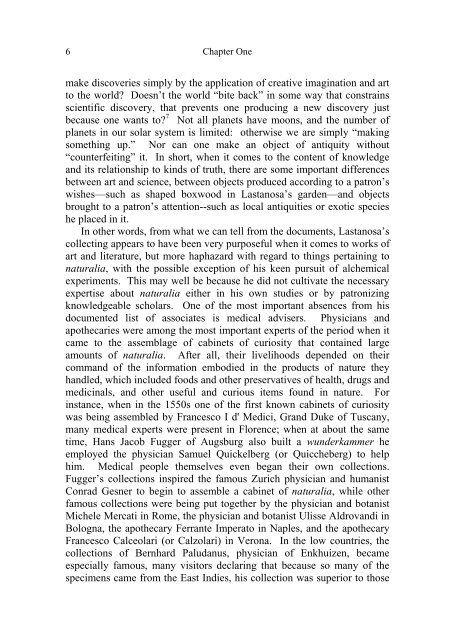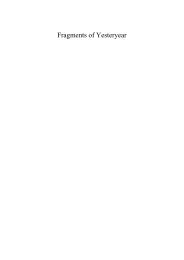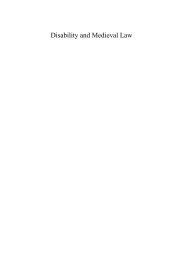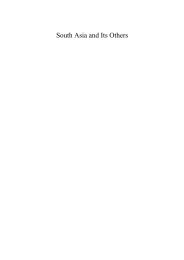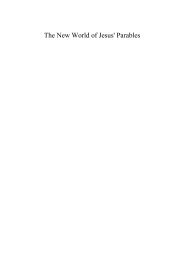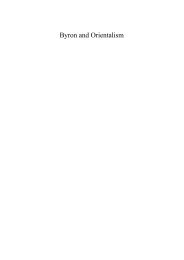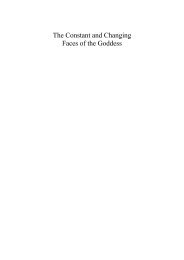The Gentleman, the Virtuoso, the Inquirer - Cambridge Scholars ...
The Gentleman, the Virtuoso, the Inquirer - Cambridge Scholars ...
The Gentleman, the Virtuoso, the Inquirer - Cambridge Scholars ...
You also want an ePaper? Increase the reach of your titles
YUMPU automatically turns print PDFs into web optimized ePapers that Google loves.
6<br />
Chapter One<br />
make discoveries simply by <strong>the</strong> application of creative imagination and art<br />
to <strong>the</strong> world? Doesn’t <strong>the</strong> world “bite back” in some way that constrains<br />
scientific discovery, that prevents one producing a new discovery just<br />
because one wants to? 7 Not all planets have moons, and <strong>the</strong> number of<br />
planets in our solar system is limited: o<strong>the</strong>rwise we are simply “making<br />
something up.” Nor can one make an object of antiquity without<br />
“counterfeiting” it. In short, when it comes to <strong>the</strong> content of knowledge<br />
and its relationship to kinds of truth, <strong>the</strong>re are some important differences<br />
between art and science, between objects produced according to a patron’s<br />
wishes—such as shaped boxwood in Lastanosa’s garden—and objects<br />
brought to a patron’s attention--such as local antiquities or exotic species<br />
he placed in it.<br />
In o<strong>the</strong>r words, from what we can tell from <strong>the</strong> documents, Lastanosa’s<br />
collecting appears to have been very purposeful when it comes to works of<br />
art and literature, but more haphazard with regard to things pertaining to<br />
naturalia, with <strong>the</strong> possible exception of his keen pursuit of alchemical<br />
experiments. This may well be because he did not cultivate <strong>the</strong> necessary<br />
expertise about naturalia ei<strong>the</strong>r in his own studies or by patronizing<br />
knowledgeable scholars. One of <strong>the</strong> most important absences from his<br />
documented list of associates is medical advisers. Physicians and<br />
apo<strong>the</strong>caries were among <strong>the</strong> most important experts of <strong>the</strong> period when it<br />
came to <strong>the</strong> assemblage of cabinets of curiosity that contained large<br />
amounts of naturalia. After all, <strong>the</strong>ir livelihoods depended on <strong>the</strong>ir<br />
command of <strong>the</strong> information embodied in <strong>the</strong> products of nature <strong>the</strong>y<br />
handled, which included foods and o<strong>the</strong>r preservatives of health, drugs and<br />
medicinals, and o<strong>the</strong>r useful and curious items found in nature. For<br />
instance, when in <strong>the</strong> 1550s one of <strong>the</strong> first known cabinets of curiosity<br />
was being assembled by Francesco I d' Medici, Grand Duke of Tuscany,<br />
many medical experts were present in Florence; when at about <strong>the</strong> same<br />
time, Hans Jacob Fugger of Augsburg also built a wunderkammer he<br />
employed <strong>the</strong> physician Samuel Quickelberg (or Quiccheberg) to help<br />
him. Medical people <strong>the</strong>mselves even began <strong>the</strong>ir own collections.<br />
Fugger’s collections inspired <strong>the</strong> famous Zurich physician and humanist<br />
Conrad Gesner to begin to assemble a cabinet of naturalia, while o<strong>the</strong>r<br />
famous collections were being put toge<strong>the</strong>r by <strong>the</strong> physician and botanist<br />
Michele Mercati in Rome, <strong>the</strong> physician and botanist Ulisse Aldrovandi in<br />
Bologna, <strong>the</strong> apo<strong>the</strong>cary Ferrante Imperato in Naples, and <strong>the</strong> apo<strong>the</strong>cary<br />
Francesco Calceolari (or Calzolari) in Verona. In <strong>the</strong> low countries, <strong>the</strong><br />
collections of Bernhard Paludanus, physician of Enkhuizen, became<br />
especially famous, many visitors declaring that because so many of <strong>the</strong><br />
specimens came from <strong>the</strong> East Indies, his collection was superior to those


